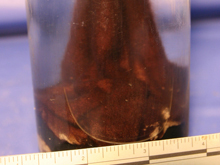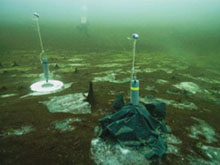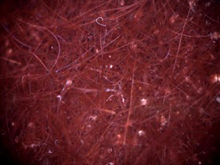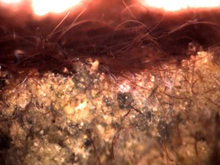Purple Microbial Mats
A 'finger' collected on September 3 from the Middle Island Sinkhole. Click image for larger view and image credit.
Microbial mat community in the Middle Island submerged sinkhole in Lake Huron. Image courtesy of Tane Casserly, NOAA, 2007.Click image for larger view and image credit.
Typical surface view of purple mat surface at Middle Island showing purple filaments. Some white filaments can also be observed. Image courtesy of Thunder Bay Sinkholes 2008.Click image for larger view and image credit.
September 4 , 2008
Scott Kendall
Researcher
Annis Water Resources Institute
Today all vessels stay at port due to weather conditions with winds in excess of 20 knots and wave heights up to 7 feet. Also, we are getting a good bit of rain from the remnants of Hurricane Gustav.
However the work continues in the lab at NOAA's Thunder Bay National Sanctuary with samples collected yesterday, and onboard the R/V Laurentian, the remote operated vehicle (ROV) equipment is being fine tuned to be ready when the weather breaks.
In the lab, we are using a stereomicroscope to discover the microscopic details of mat structure and conducting experiments to determine aspects of mat physiology.
The most noticeable aspect of the submerged sinkholes at El Cajon and Middle Island in Lake Huron are the interesting purple microbial mats that cover the lake floor, rocks, and wood debris. Yesterday, samples of the purple mats and fingers from the lake floor at the Middle Island sinkhole were collected by divers and brought back to the lab for microscopic observation and testing.
Last night and today, we have been looking at the fine detail of the mats to describe the mat structure and determine what types of microorganisms are present in the mats.
Also we are interested in learning about the sediment particles that are closely associated with the mats. Ultimately, we hope to understand the importance of each living and non-living component of the mat and tell the story of why these mats have formed in this sinkhole and how the living components of the mat work together as a balanced ecosystem.
The surface of the mats was comprised mainly of purple filamentous cyanobacteria that are capable of producing energy through photosynthesis. The width of the purple filaments and cell shapes was not uniform suggesting that more than one species may be present.
When viewed from the surface, white filaments were also observed scattered throughout the mat. Also, an occasional nematode, protozoan, worms, and tardigrade was observed in close association with the mat. Underlying the purple mat is a layer of white crystals interspersed with white filaments and diatoms. A simple acid test on the white crystals indicates the presence of calcium carbonate.
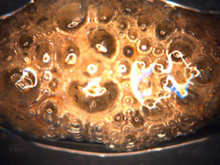
When sulfuric acid was dripped onto the crystals they fizzed and released what is likely carbon dioxide gas. This indicates that the crystals contain calcium carbonate. Image courtesy of Thunder Bay Sinkholes 2008. Click image for larger view and image credit.
Microbial mats from Lake Hoare in Antarctica show similar appearance to those of Middle Island sinkhole. Click image for larger view and image credit.
On the lake floor in the Middle Island sinkhole, the microbial mats lay flat along the lake floor and occasionally form fingers and domes that extend upwards. These raised structures of the mat are held up by trapped gases that will be analyzed to determine their composition.
Truly, these mats represent a unique ecosystem in the freshwater of the Great Lakes, but microbial mats with similar characteristics have been discovered growing on the lake floor in the frozen lakes of Antarctica like at Lake Hoare. Previous genetic analyses by our team have shown that the Lake Huron purple mats are closely related to some Antarctic mats.
See the images on this page to compare for yourself.
Sign up for the Ocean Explorer E-mail Update List.


















